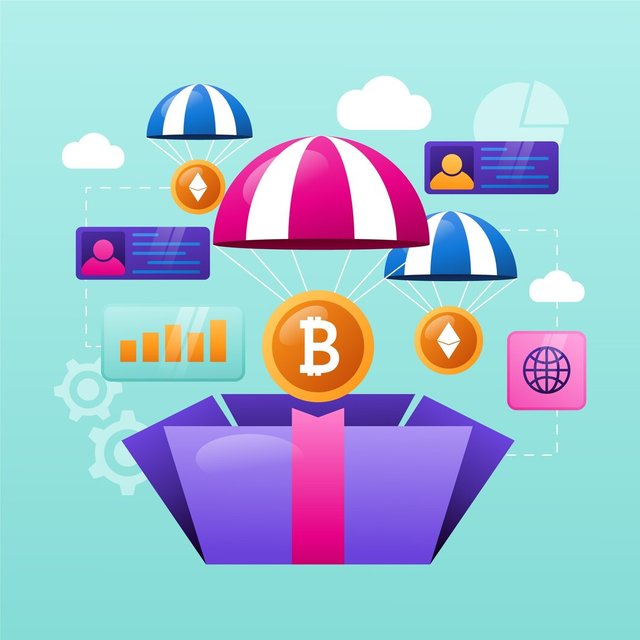SEC-S19/W1 | Crypto Opportunities : Airdrops and Giveaways

Hello everyone! I hope you are all doing well and enjoying life with the blessings of Allah Almighty. I am happy to take part in the exciting challenge hosted by SteemitCryptoAcademy community . So, without any further delay, let's dive right in! Shall we ? ........, Okay , Okay😊! .
Explain what a cryptocurrency airdrop is and what its main objectives are. Give examples of projects that have used airdrops. |
|---|
An airdrop is the process in which cryptocurrency tokens get distributed to several wallet addresses as some kind of promotion for that particular cryptocurrency project. This quickly spreads the new coins to a large number of wallet holders and enables more people to get familiar with the project.
The primary motive behind airdrops is building a large community within which maximum numbers of individuals are able to use and discuss the tokens provided by distributing them free of cost.
They can reward loyal users or lend an attraction toward new ones. In most cases, they will incentivize people to test new platforms or services without the feeling of needing to spend money.
Giveaways are similar in their mechanism of operation. They tap into interest by, perhaps, asking users to follow social media accounts or to share content and provide them with free tokens.
Understand airdrops and giveaways. Such opportunities will be instrumental in growing users' crypto portfolios and hence fostering the growth of promising projects that might be huge in the future.
Crypto airdrops have given users nearly $4 billion in value this year. Free token giveaways help projects grow by having more users involved. Many big airdrops are expected in 2024 and are offering much more opportunities to users for getting free tokens.
As for the biggest airdrops this year, the list includes Jupiter, Starknet, and Notcoin. Each of these above-mentioned projects gave out approximately $1 bln in tokens. Events like this have brought tremendous attention to spread the word about these projects.

Other interesting airdrops were by Solana and projects under Ethereum— such as Wormhole, Ether.Fi, FriendTech, and Wen— that gave out numerous tokens. These airdrops helped galvanize these projects to achieve a nimble sense of recognition and build a firm community.
Participation in these airdrops grows users' cryptocurrency holdings without spending money. Getting to know about and being part of the events of airdrop is a great means of supporting new projects and reaping from their potential success in the future.
What is the difference between an airdrop and a giveaway in the field of cryptocurrencies? |
|---|
Airdrops and giveaways are the two popular strategies that cryptocurrency projects use to give away tokens with the view of engaging users. Airdrops are free distributions of tokens to a large audience, usually to foster adoption and build community.
Giveaways, on the other hand, reward users with tokens upon the performance of certain tasks—for example, engagement on social media or participation in events organized within the community.
The strategies were put in place to make sure there is enhanced visibility and user activity across the competitive crypto ecosystem.
Airdrops: Dispersion of Tokens on a Wide Scale
Airdrops in cryptocurrency refer to a scenario whereby tokens are distributed to a large group of people for free.
It is one of the methods the blockchain projects use to spread their tokens quickly for building a community. Stellar, a prominent blockchain platform, conducted airdrops hoping for its adoption and the use of its XLM tokens.
An airdrop can occur automatically to some cryptocurrency holders when registered on specific platforms.
Examples of Airdrops:
Stellar (XLM): Stellar has conducted previous airdrops intended to give users XLM tokens. Their airdrops have the aim of increasing the number of users in Stellar's network exploring its functionality.
Uniswap (UNI): Uniswap is the decentralized exchange on Ethereum conducting an airdrop of UNI tokens for users who interacted with their platform earlier. With every action, more popularity was added to Uniswap, and more liquidity was attracted to its exchange.
Giveaways: Engaging Users Through Actions
Giveaways within the cryptocurrency space are where free tokens are given to users for doing things such as following social media accounts, sharing, and engaging in community events.
Usually, giveaways are held to increase a project's or platform's engagement and visibility. Ontology, for example, is also a blockchain network that has used giveaways for encouraging participation and rewarding its community members.
Examples of Giveaways:
Ontology (ONT): Ontology has hosted giveaways where users could receive ONT tokens by performing simple tasks like joining their Telegram group or retweeting posts from the ontology handlers on Twitter. These giveaways helped to build its community and amplify awareness of blockchain solutions among people.
Solana-Based Projects: Many projects built on top of Solana Chain have used giveaways as a way to onboard its users and get them to interact with their dApps. Most of these activities are structured so as to require users either to interact with their decentralized applications or to share their projects in social media in exchange for tokens.
The two important strategies in the cryptocurrency world with regard to executing effective token distribution to users are airdrops and giveaways. Airdrops represent the bulk distribution of tokens with the purpose of enabling adoption and building a community.

For instance, Steem—the blockchain-based social media platform—initiated airdrops in distributing STEEM tokens to the very early adopters and active participants on Steemit. Contributors and curators on Steemit were awarded STEEM tokens for their contribution or curation of posts, thereby incentivizing further adoption and growth of the community.
Some examples of airdrops involving Steem are as follows:
Steemit Airdrop: Steemit was giving away STEEM tokens to any user who signs up for an account and creates content. This encourages usage and creation of content on the platform.
Steem Engine Airdrops: Steem Engine enables Airdrops of new Tokens to STEEM holders thus engaging and increasing utility within the Steem ecosystem.
Giveaways reward users with tokens for completing certain actions, usually related to social media engagement or promotional activities. This works in spreading a project's visibility and engaging more users.
Examples of Steem-related Giveaway Events:
Steem Monsters Giveaway: Steem Monsters (now Splinterlands) created giveaways of in-game assets and STEEM tokens by executing social media contest activities that helped increase engagement within the community and make sure that its players were rewarded.
Community Initiatives: Various communities on Steem provide giveaways as a reward to active members of the community in the shape of high-quality posts or even for supporting community projects with STEEM token-based rewards.
What are the advantages and disadvantages of airdrops for project developers and participants? Use cases involving the Steem token if possible. |
|---|
Advantages for Project Developers:
Increased Awareness: Airdrops can create buzz and attract attention to new projects. For example, when Steemit launched, airdrops of STEEM tokens helped attract users to the platform, increasing visibility and user engagement.
Community Building: By distributing tokens to a large audience, projects can quickly build a community. Steemit's airdrop strategy helped create a robust community of content creators and curators, essential for the platform's growth.
User Incentives: Airdrops incentivize users to participate in the ecosystem. For instance, Steemit users who received STEEM tokens were motivated to contribute more content and engage with the platform, enhancing overall activity.
Disadvantages for Project Developers:
High Costs: Airdropping tokens can be expensive, especially if the project distributes a large number of tokens. Developers must ensure they have the resources to support the airdrop and its aftermath.
Temporary Engagement: Airdrops might attract users only for the free tokens. Once they receive the tokens, they might not remain engaged with the project, as seen with some users on Steemit who participated only for initial rewards.
Market Impact: Distributing a large number of tokens can lead to market volatility. If many users sell their airdropped tokens simultaneously, it can negatively impact the token's price.
Advantages for Participants:
Free Tokens: Participants receive free tokens, enhancing their portfolios without any investment. Steemit users benefited from receiving STEEM tokens through airdrops, increasing their holdings.
Early Access: Airdrops often provide early access to new tokens, allowing participants to become early adopters of promising projects.
Diversification: Airdrops allow participants to diversify their crypto portfolios by acquiring various tokens from different projects.
Disadvantages for Participants:
Scams and Security Risks: Not all airdrops are legitimate. Participants need to be cautious of scams and ensure they only engage with trustworthy projects. Some users in the Steemit community have encountered fraudulent airdrops.
Tax Implications: In some regions, receiving airdropped tokens may have tax implications. Participants need to be aware of their local regulations and manage their tax responsibilities accordingly.
Market Volatility: The value of airdropped tokens can fluctuate significantly. Participants might receive tokens that quickly lose value, impacting their overall portfolio.
What are the security and regulatory challenges related to cryptocurrency airdrops and giveaways? How can these challenges be managed? |
|---|
Security and Regulatory Challenges of Cryptocurrency Airdrops and Giveaways
Security Risks:
Cryptocurrency airdrops and giveaways definitely attract scammers. There have been scandals regarding fake airdrops that end up giving away personal information and even private keys of the users. For instance, some members of Steemit were targeted by fraudulent airdrops. That is why it is paramount to ensure the authenticity of an airdrop before joining to avert such risks.
Phishing Attacks:
Such scams can clone phishing e-mails and fake websites as a way to con users of their critical information. The members must thus become extremely cautious and deal only with the concerned official sources. Checks of URLs and protecting oneself against unsolicited messages are practical ways to prevent becoming victims of such hacks.
Regulatory Challenges:
It may further face regulatory scrutiny: cryptocurrency airdrops and giveaways. Rules concerning the distribution of tokens vary across countries. In certain jurisdictions, airdropped tokens could mean income that is taxable. Therefore, projects and participants shall be knowledgeable of and in compliance with local laws to avoid lawsuits.
Market Manipulation:
Massive quantities of tokens can lead to market manipulation in the case of events such as airdrops because of their selling off quickly. This price volatility will impact directly on the reputation of the project. In this regard, airdrops should be planned by the developers to prevent the sudden fall of token value in order to ensure long-term stability.
User Privacy:
This may result in raising privacy concerns since this involves the request for personal information from airdrop participants like email addresses or social media handles. Projects are to handle data responsibly and have to be very well-equipped on policies concerning keeping participants' information protected.
Tax Implication:
Getting airdropped tokens may give rise to tax liabilities. In countries or regions where such tokens represent taxable income, they must be declared by the recipient. One should know the local tax legislation in this respect and be in a position to account for the tokens received to ensure avoidance of possible legal complications and difficulties from tax authorities.
To protect against such threats, make sure to verify the legitimacy of an airdrop before participating. It shall be based on trusted sources and involves no disclosure of personal data or private keys.
When it comes to phishing attacks, avoid opening unsolicited emails; always use websites which are authentic in their origin. Confirm the URLs and deal only with the official channels in order to protect yourself from scamming entities.
Know and respect local cryptocurrency regulation. Follow taxation requirements and legal dictates on airdropped tokens for litigation avoidance.
Avoid the manipulation of the market by appropriately strategizing the airdrop. Institute token distribution schedules so that the impact of such value tokens is avoided, thus keeping the market stable.
Be responsible with user privacy. Institute stringent measures for the protection of data. Clearly stipulate privacy policy and ensure consent before the collection of any personal information needed for participation in an airdrop.
Propose a detailed plan to organize an airdrop using the Steem token. The plan should include eligibility criteria, required participant actions, implemented safety measures, and promotional strategies to maximize impact. |
|---|
A good plan for an airdrop with Steem tokens will entail the clear specification of eligibility, what participants must do, safety measures that should be taken, and how to promote the drop.
Eligibility Criteria: A legitimate user must accord with certain criteria to participate in the airdrop of the Steem token. Furthermore, the criteria include one having an active Steemit account that has at least a 30 reputation score. The participant shall, to an extent, be a genuine user having posted or commented on the site at least 10 times in the last month. This shall, in turn, follow official Steemit accounts on all the major social media sites.
User Actions: The participants shall undertake a number of actions in order to be whitelisted for the airdropped Steem token. First is registration for the airdrop. This enables them to provide their Steemit username and a verified email address.
Secondly, there is a secure authentication procedure, which will verify identity and prevent double entries. Then, they will accept our terms and conditions of this campaign by agreeing that their data can be collected accordingly for this Airdrop.
Safety Measures: The safety of the participants and protection from cyber threats are considered major issues. These will ensure that two-factor authentication, registration, and verification of participants' information are carried out as a step of safety. All sensitive information pertaining to the athletes is stored using encrypted channels and secure servers.
Regular security audits and penetration tests will be conducted to find and patch potential vulnerabilities. It shall ever educate participants on common phishing scams by giving guidelines on how best their accounts and personal data can be protected.
Promotional Strategies: Strategic promotional efforts will be needed for the execution of maximum impact and reach for which the Steem token airdrop is scheduled. A proper awareness campaign needs to be organized on relevant social media platforms like Twitter, Facebook, and LinkedIn. In this case, a partnership with influential users on Steemit and community leaders would be important to endorse the airdrop to their respective networks and encourage participation.
This includes holding live webinars or AMA sessions to engage with the community and address all queries regarding the airdrop. Referring to bonuses to the inviting participants would further incentivize them to promote it virally.
Distribution and Follow-up: The moment the airdrop event is over, Steem tokens will get directly distributed into the wallets of all eligible participants on the Steem blockchain. Clear instructions with support regarding how to access and efficiently use the airdropped tokens will be provided.
The success rate for this campaign will be determined by the participant feedback and metrics of engagement. A post-airdrop survey will collect insights to drive improvement in future token distribution strategies based on participant feedback. This will ensure that constant evolution comes with community satisfaction.
Organizers will create successful Steemit token airdrops by following through on these aesthetic measures: compliance with eligibility requirements, effective engagement of participants, tending to security concerns, and maximizing promotional impact within the cryptocurrency community.
Conclusion |
|---|
kind Regards
@artist1111

Adieu, folks!
May the winds of fortune
carry you to greatness!
May the winds of fortune
carry you to greatness!
Upvoted. Thank You for sending some of your rewards to @null. It will make Steem stronger.
Hi @artist1111
I have read you post, you have beautifuly answered all the questions and your post explain all aspects relating to airdrops and giveways in detail. First you talk about the main objective behind the airdrops and giveways. Ofcourse their main objective is of making community and promoting the token. Than you explain some examples like XLM and uniswap for airdrop and ontology and solana base airdrops for giveways. You also give detail about steem based airdrops. At the end you proposed an airdrop in which you beautifuly described all apsects like security, participants contributing actions etc.
Finally I want to say that your content is fully knowledge base, thanks a lot for sharing this post with us. Wishing you best of luck for contest bro.
I appreciate you for taking you time to explain and highlight it. I do airdrop as well. A couple of months ago, I benefited from notcoin. And this is how wonderful crypto currency his.
TEAM 2
Congratulations! This post has been voted through steemcurator04. We support quality posts, good comments anywhere and any tags.Cryptocurrency airdrops have brought users nearly $4 billion in value this year. I was impressed with that information, friend @artist1111.
We are talking about a billion-dollar market where a little piece of that can be ours! The Notcoin project was spectacular and the "Hasmter Kombat" project is expected to be even bigger.
I'm excited about the fact that we can take the profits from an airdrop and reinvest them in another project that helps us multiply the money, and all of this starting without a cent! Just dedication, perseverance and patience.
Good luck in the contest! Greetings and blessings for your life and family.